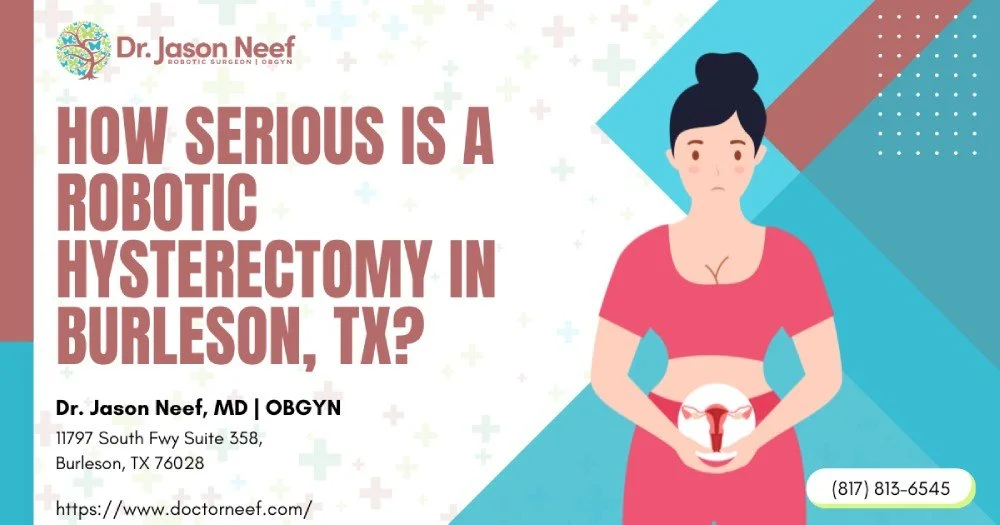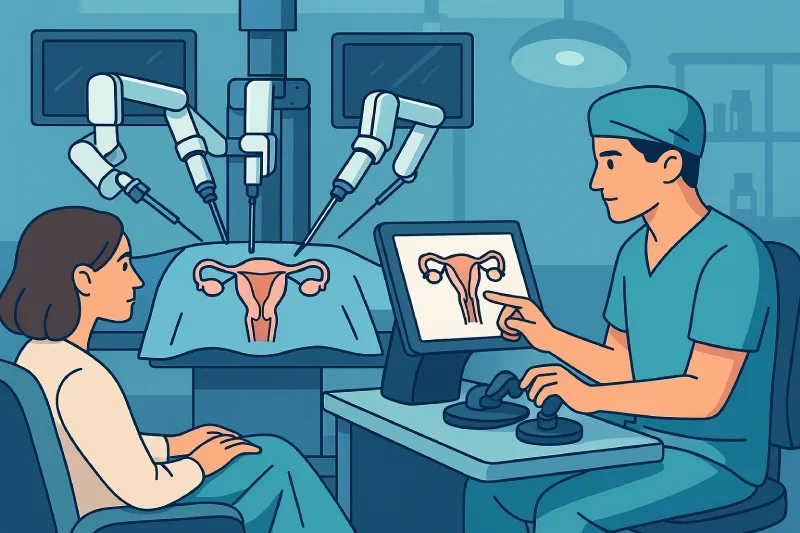Robotic Hysterectomy for Endometriosis: Procedure, Benefits, and What to Expect
Categories:
By: Ethan Cole
Endometriosis can cause severe pelvic pain, infertility, and ongoing inflammation that disrupt daily life. For those who haven’t found relief with medication or less invasive treatments, robotic hysterectomy offers a surgical solution. This guide explains how the procedure works, who it’s for, and what recovery looks like—so you can make an informed decision with your doctor.
Key Takeaways
Robotic hysterectomy uses small incisions and precision instruments to remove the uterus, offering improved accuracy, less trauma, smaller scars, and faster recovery compared to open or traditional surgical methods.
This approach is particularly valuable for advanced endometriosis cases involving pelvic adhesions, organ involvement, or prior surgeries, where precision and visualization significantly improve safety and treatment success.
Patients benefit from reduced pain, less blood loss, shorter hospital stays, and quicker return to daily activities, making robotic hysterectomy a safer, more patient-friendly treatment option.
While hysterectomy ends the ability to get pregnant, preserving ovaries during robotic surgery helps maintain natural hormone function, reducing the risks associated with surgical menopause and long-term hormonal changes.
Recovery after robotic hysterectomy typically takes 4–6 weeks, with light activity resuming earlier than open surgery, making it a preferred option for patients seeking less downtime and faster healing.
Outcomes are highly dependent on surgeon expertise with robotic systems; choosing an experienced, board-certified gynecologic surgeon ensures greater precision, lower risks, and improved long-term relief from endometriosis symptoms.
What Is a Robotic Hysterectomy?
Robotic hysterectomy is a modern approach to removing the uterus using precision-guided instruments. It’s part of the broader category of minimally invasive surgery, but with added control and clarity. Understanding how this technique works—and how it compares to other surgical options—can help clarify its role in treating endometriosis.
Definition & Technology Overview
Robotic hysterectomy uses a computer-assisted surgical system to remove the uterus through small abdominal incisions. The surgeon controls robotic arms equipped with surgical instruments while viewing the inside of the pelvis through a 3D high-definition camera. The system responds to the surgeon’s movements in real time, translating hand motions into steady, scaled-down actions with enhanced precision.
How It Differs from Traditional and Laparoscopic Hysterectomy
|
Feature |
Robotic Hysterectomy |
Laparoscopic Hysterectomy |
Open (Abdominal) Hysterectomy |
|
Incisions |
Small (5–10 mm), multiple |
Small (5–10 mm), multiple |
Large (5–7 inches) |
|
Surgeon Control |
Console-guided robotic arms |
Hand-held tools |
Direct manual access |
|
Visualization |
3D magnified view |
2D camera view |
Direct line of sight |
|
Precision |
Very high |
Moderate |
Standard |
|
Recovery Time |
2–4 weeks |
2–4 weeks |
6–8 weeks |
|
Scarring |
Minimal |
Minimal |
More visible |
Why Robotics Matter in Gynecologic Surgery
For conditions like endometriosis, where tissue can grow in hard-to-reach areas, robotics offers a significant advantage. The enhanced visuals and wristed instruments allow surgeons to navigate delicate pelvic structures with greater accuracy. This is especially important when removing endometrial lesions near the bladder, bowel, or ovaries. Robotics helps reduce the risk of damage while increasing the likelihood of complete lesion removal.
Why Consider Robotic Surgery for Endometriosis?
Endometriosis can be difficult to treat—especially in advanced stages. While hormonal therapy and conservative surgery work for some, others need more definitive solutions. Robotic hysterectomy offers a precise surgical option for removing the uterus and, in many cases, deep endometrial tissue that causes pain and inflammation.
When Is a Hysterectomy Recommended for Endometriosis?
Hysterectomy is typically reserved for people with moderate to severe endometriosis who haven’t responded to other treatments. It may be considered when:
Pain continues despite hormonal therapy or laparoscopy
Endometrial lesions affect multiple organs
Fertility is no longer a goal
Quality of life is significantly reduced
It’s not always the first step, but it can be the right one in carefully selected cases.
Challenges of Severe (Stage III–IV) Endometriosis
In advanced cases, endometrial tissue may invade the bowel, bladder, or other pelvic organs. Scar tissue, known as adhesions, can distort anatomy and make surgery more complex. These cases require precise dissection and clear visualization—something robotic systems are uniquely equipped to provide.
Advantages in Removing Deep Lesions and Adhesions
Robotic surgery improves access to hard-to-reach areas of the pelvis and allows for fine motor control when removing endometrial tissue. Key benefits include:
Better visualization of dense adhesions
Increased precision in cutting and cauterizing tissue
Reduced risk of damaging nearby organs
More complete removal of lesions, which may lower recurrence rates
How the Procedure Works
Robotic hysterectomy is performed in a hospital under general anesthesia. The procedure follows a series of controlled steps, beginning with small incisions and ending with the removal of the uterus and, in some cases, the ovaries or other affected tissue. Here's how it typically unfolds.
Small Incisions for Robotic Arms and Camera
The surgeon begins by making several small incisions in the lower abdomen, usually between 5 to 10 millimeters wide. These act as entry points for the robotic arms, camera, and surgical instruments. Carbon dioxide gas is used to inflate the abdomen slightly, creating a clearer space to work inside the pelvis.
Surgeon Console with 3D Vision and Wristed Instruments
From a nearby console, the surgeon operates the robotic system using hand controls and foot pedals. The setup includes:
3D high-definition camera for magnified views of the pelvic cavity
Wristed instruments that rotate and bend beyond the range of human hands
Tremor filtration for smoother, steadier movements
Real-time control over cutting, suturing, and cauterizing
This setup allows for more precise dissection, especially when working near sensitive structures.
Steps of the Surgery: From Lesion Removal to Possible Oophorectomy
Insert robotic instruments and camera through abdominal ports
Locate and remove visible endometrial lesions
Separate the uterus from surrounding structures
Cauterize and cut supportive ligaments and blood vessels
Remove the uterus through the vagina or small incision
Optionally remove one or both ovaries (oophorectomy), if medically indicated
Inspect pelvic area for bleeding or missed tissue
Remove instruments and close incisions with dissolvable sutures
Average Surgery Duration
Robotic hysterectomy for endometriosis typically takes between 2.5 to 4 hours, depending on the severity of the disease, extent of adhesions, and whether additional procedures (like oophorectomy or bowel dissection) are required. Complex cases may take longer, but the precision offered by robotics helps minimize complications.
Key Benefits of Robotic Hysterectomy for Endometriosis
Robotic surgery offers multiple advantages for people with endometriosis, especially those with advanced disease. From better precision to faster recovery, these benefits make it a strong option when hysterectomy becomes necessary.
Minimally Invasive with Reduced Blood Loss
Robotic hysterectomy is performed through small incisions, which means less trauma to the body. The robotic system allows for careful control of bleeding, often reducing the need for transfusions. This is especially helpful when operating around inflamed or scarred tissue caused by endometriosis.
Less Pain, Shorter Recovery, and Minimal Scarring
Compared to open surgery, robotic procedures typically result in:
Less post-operative pain
Shorter hospital stay (often same-day or overnight)
Faster return to normal activities
Smaller, less noticeable scars
These outcomes make recovery easier and reduce the physical toll of surgery.
Precision in Treating Advanced or Organ-Involving Endometriosis
Endometrial implants can form on the bladder, bowel, or other organs. Robotic tools allow surgeons to operate with greater dexterity and visibility in tight or delicate spaces. This precision improves the chances of complete lesion removal, which is key to long-term symptom relief.
Improved Fertility and Symptom Relief Outcomes
While a hysterectomy ends the possibility of pregnancy, it may still improve outcomes for those who’ve undergone multiple unsuccessful treatments. In some cases, ovaries are preserved to maintain hormonal balance. Robotic precision also helps remove painful implants that contribute to inflammation, pelvic pain, and impaired fertility.
Recovery Timeline After Robotic Hysterectomy
Recovery from robotic hysterectomy tends to be smoother than with open surgery, but the timeline still varies from person to person. Knowing what to expect each step of the way can help you plan, rest properly, and avoid complications.
Hospital Stay: Same Day or 1-Night Discharge
Most patients go home the same day or after one night in the hospital. You’ll be monitored as you wake from anesthesia and should be up and walking within a few hours. Pain is usually manageable with oral medications by the time of discharge.
Post-Operative Symptoms: Spotting, Cramping, Energy Levels
You may notice a few common symptoms after surgery:
Vaginal spotting for several days
Mild to moderate cramping
Shoulder or upper abdominal discomfort from residual gas
Fatigue or low energy that can last up to 1–2 weeks
Mood changes or tearfulness, especially if hormones shift post-op
Activity Guidelines: Lifting, Work, and Sexual Activity
Avoid lifting over 10 pounds for at least 2 weeks
Short walks daily help circulation and reduce clot risk
No vaginal activity (including sex or tampons) until cleared—usually after 6 weeks
Return to work is possible in 2–4 weeks depending on job demands
Driving is usually safe once you’re off narcotics and can move comfortably
Full Recovery Timeline (3–6 Weeks)
Most people feel significantly better by week 3. Light exercise, social activity, and work can often resume by week 4. Complete internal healing typically takes 6 weeks. If the surgery included ovary removal, some patients may start hormone therapy soon after.
Risks and Considerations of Robotic Hysterectomy for Endometriosis
While robotic hysterectomy is generally safe, it’s still major surgery. Understanding the potential risks helps you prepare and make informed decisions alongside your care team.
Common Risks: Infection, Bleeding, Organ Injury
As with any abdominal surgery, there’s a risk of:
Infection at the incision sites or internally
Bleeding during or after the procedure
Injury to nearby organs, such as the bladder, bowel, or ureters
These complications are uncommon, especially in experienced hands, but they can happen—particularly in cases with extensive adhesions or deep endometriosis.
Rare Events: Conversion to Open Surgery
In rare cases, the surgeon may need to switch from robotic to open surgery. This may be due to bleeding, scar tissue, or unclear anatomy. If this happens, recovery may take longer.
Longer Operative Time vs. Conventional Laparoscopy
Robotic procedures can take slightly longer than traditional laparoscopy, especially in complex cases. While this doesn’t usually affect outcomes, it may require longer time under anesthesia.
Importance of Surgeon Expertise
Outcomes depend heavily on the surgeon’s experience with both robotics and endometriosis. Choosing a board-certified gynecologic surgeon who regularly performs robotic procedures improves safety, precision, and long-term results.
Who Should Consider Robotic Hysterectomy for Endometriosis?
Robotic hysterectomy isn’t the first-line treatment for endometriosis, but it may be the right choice in specific cases. Knowing when this surgery makes sense can help guide your conversation with a gynecologic specialist.
Ideal Candidates: Severe Pain, Infertility, Failed Medical Therapy
This procedure is often recommended for people who:
Have persistent pelvic pain despite hormonal treatment
Experience infertility linked to advanced-stage endometriosis
Have undergone one or more prior surgeries with limited relief
No longer wish to preserve fertility and want definitive treatment
It’s especially useful in cases where endometriosis has spread to other organs or when symptoms severely affect quality of life.
Fertility Preservation vs. Complete Hysterectomy
A hysterectomy removes the uterus, which ends the possibility of pregnancy. However, in some cases, the ovaries may be preserved to maintain hormonal function. It’s important to weigh:
Whether future pregnancy is a goal
The severity of endometrial lesions
Risks of recurrence if reproductive organs are left intact
Some patients choose uterus removal while preserving one or both ovaries. Others opt for complete removal to minimize symptom return.
Discussing Surgical Goals with Your Gynecologic Surgeon
Before making a decision, talk openly with your surgeon about:
Your long-term goals
Hormonal considerations
Risks and benefits of ovary removal
Pain management strategies post-surgery
A personalized approach ensures the procedure aligns with both medical needs and personal values.
Conclusion
Robotic hysterectomy is a safe, effective, and minimally invasive treatment option for women with endometriosis, including advanced cases. By combining enhanced visualization with precise surgical control, it allows for thorough disease removal, smaller scars, and faster recovery compared to traditional surgery. While pregnancy is no longer possible after hysterectomy, preserving the ovaries can help maintain natural hormone function and support long-term health.
For many patients, robotic-assisted surgery not only relieves pain but also improves quality of life by reducing complications and shortening downtime.
Because each case is unique, discussing your condition, goals, and surgical options with an experienced surgeon like Dr. Jason Neef is the best way to determine whether robotic hysterectomy is the right path for you.
Schedule your robotic hysterectomy consultation with Dr. Neef.
Call (817) 568-8731Categories:
Frequently Asked Questions
-
Recovery usually takes 4–6 weeks. Light activities can begin within a few days, and many return to work by 2 weeks. Full healing and lifting restrictions last 6 weeks.
-
Yes. Robotic hysterectomy is safe and effective for stage IV endometriosis. It enables precise excision of deep lesions with lower complications but requires an experienced surgeon for optimal outcomes.
-
Pros: enhanced visualization, precision, and maneuverability in complex cases. Cons: longer operative times and no tactile feedback. Both methods are minimally invasive with similar recovery times.
-
Yes. Pregnancy is not possible after hysterectomy, since the uterus is removed. If ovaries are preserved, hormones continue normally. Fertility-preserving excision may be considered for endometriosis instead.
-
It depends on disease severity and symptoms. If ovaries are healthy, they can be preserved to maintain hormones. Removal triggers menopause but may reduce recurrence risk in severe disease.
-
Most patients leave the hospital the same day or within 24 hours, depending on complexity and recovery speed. Shorter stays are a major advantage over open surgery.
-
Risks include bleeding, infection, organ damage, or anesthesia complications. Robotic surgery generally reduces these risks compared to open surgery but requires proper patient selection and skilled surgeons.
-
Pain is typically mild to moderate and managed with over-the-counter pain relievers or short-term prescriptions. Patients usually report less pain compared to open abdominal hysterectomy.
-
Most patients resume light activity within one week. Strenuous exercise and heavy lifting should be avoided for about 6 weeks to allow complete internal healing.
-
Robotic hysterectomy often provides significant symptom relief, especially for advanced endometriosis. However, results depend on disease extent and whether ovaries are preserved, as hormone production can influence recurrence.











